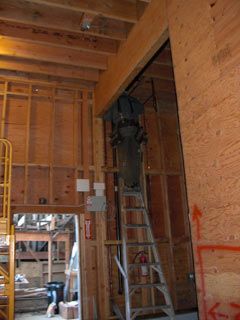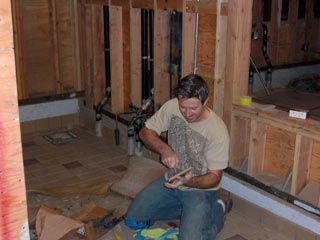

Curious about what goes into opening a restaurant? Each month we'll be checking in on the build-out process of flour + water, a new restaurant project that is underway in the Mission. The hardhat will highlight the unique coups and complications when opening a restaurant in San Francisco. This section will be written by Erin Archuleta, tablehopper intern and half of the talent behind local outfit Ichi Catering.
These next few weeks may be the most crucial for the flour + water build out. Now that their plans have been approved by the city planning and building departments, David White and David Steele are moving forward with crews of plumbers, electricians, tilers, and drywall installers.
David White's project manager process has moved a bit like this (while reading say this list as fast as you can, and you sort of get a sense of the pace these guys have been working at the past few weeks): get the drains in the floors, put in all the rough plumbing, venting for the kitchen, lay all concrete slabs--then acid wash, stain, and cover the floors, install the walk-in box (the giant fridge), tile the floors, cove the kitchen floors, do all the remaining plumbing simultaneously, then have the electricians work in all the conduit, get in the mechanical engineer to vent the hood, finish up the roof, get all the insulation in, and then (drum roll here)… sheet rock.
Last week David W. had some major deadlines to meet. In order to get the sheet rock crew in they needed to finish framing all the walls for the electricians so that they could run conduit, speaker, and computer wires before they become enclosed and are taped and mudded. With this speedy and interconnected process, even small nuances like the weather can affect whether or not the build turns out smoothly.
For instance, the sheet rock process will need two days to install, four days to hang, and then eight to mud and tape. The taping is critical because it's a fire tape that creates more fireproof seams in the walls, protecting the inhabitants and the structure itself from the rapid spread of a blaze. The real doozy is that if there's any rain, the mud won't dry in time. If the mud doesn't dry in time, then it holds up the rest of the building process.
And, much of the process hinges on city inspections. The order of operations for this is pretty intense. First, the roof must be signed off on, then the framing, the HVAC, the walk-in box, the plumbing, the electrical, the cover-up, insulation, and then the nailing inspection. The city literally comes out to count the number of nails between studs hanging the sheet rock. If they find anything unsatisfactory, the guys have to do it again and schedule a new inspection. Each inspection takes about a week (or longer) to schedule.
Their crews are working through the holidays to keep on the original opening schedule; the nailing inspection is scheduled on New Year's Eve, and the mudding inspection is scheduled for New Year's Day.
Wishing all of you just a little rest over the holiday season, and we can't wait to see the place with walls! Flour + Water



